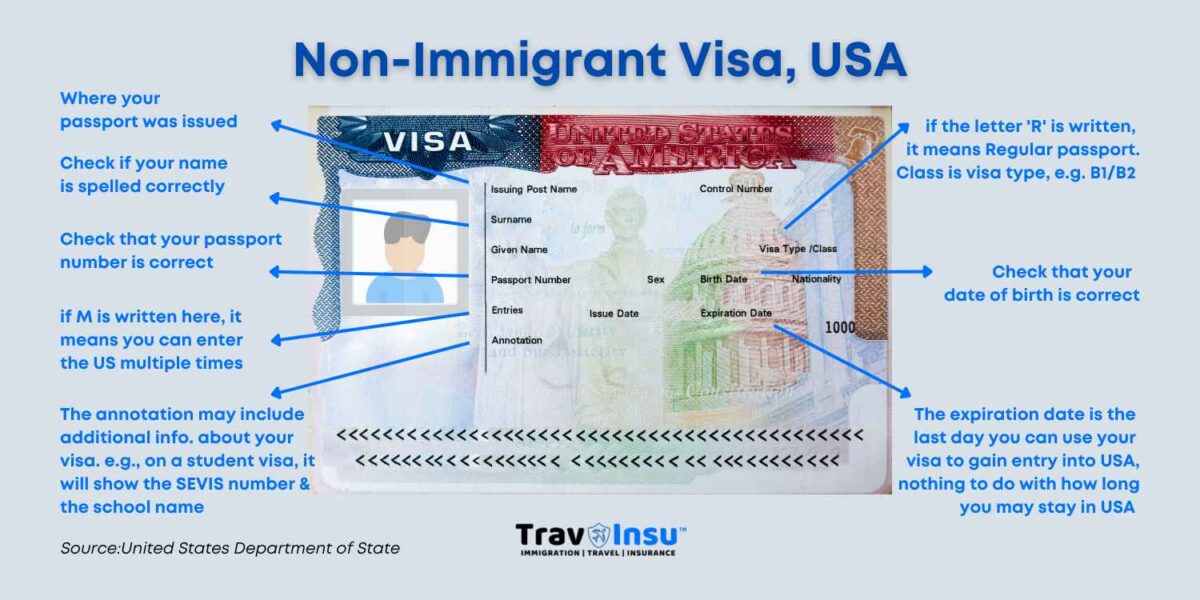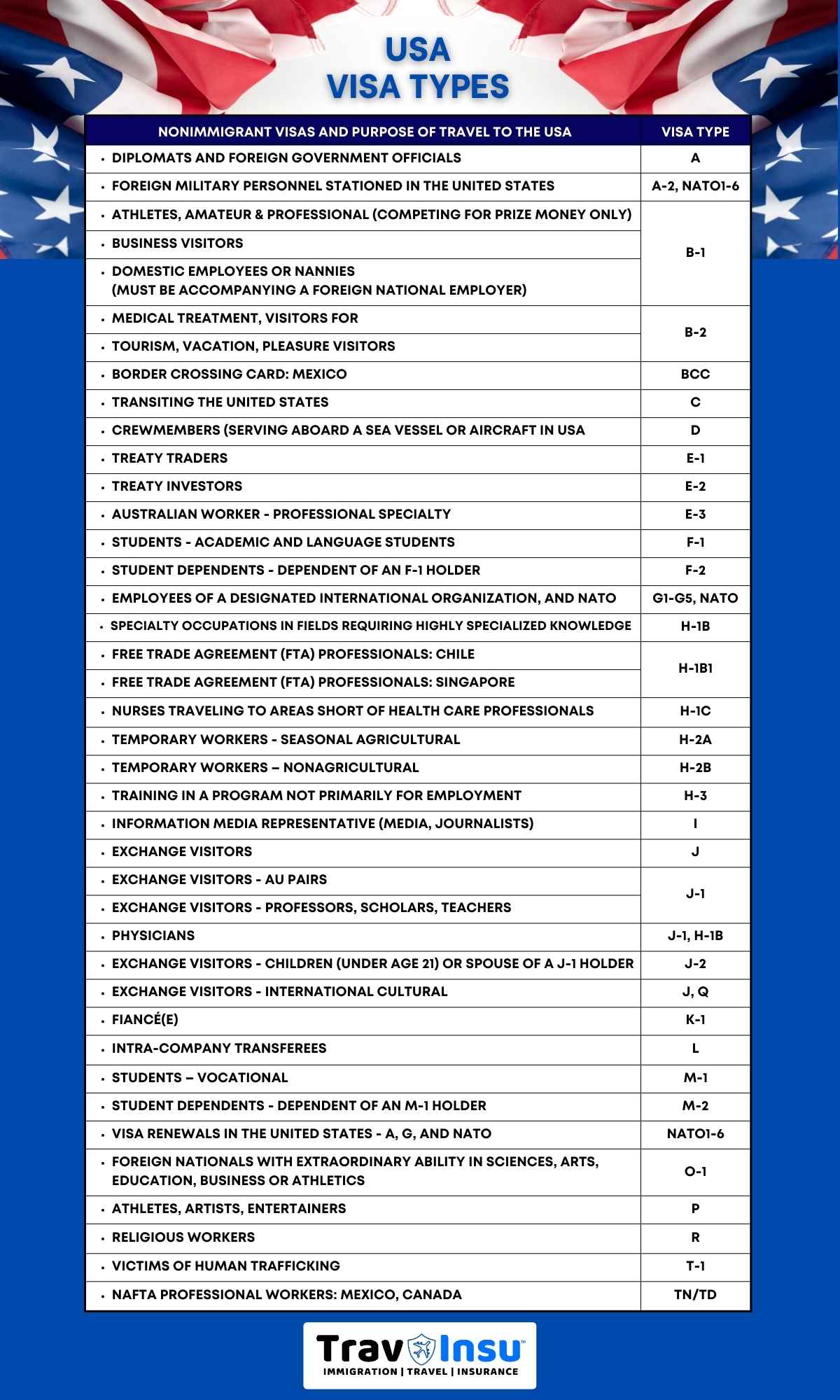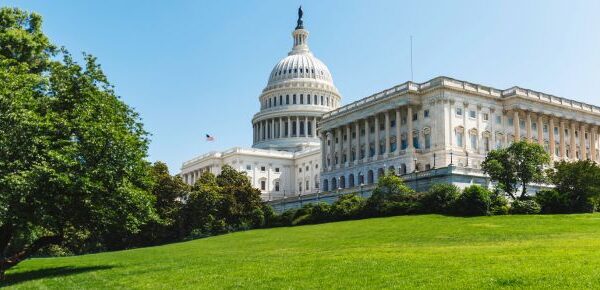What are the US Visa Types – Guide

Planning to visit the US? Let us understand the various US Visa types and their categories. Under US immigration rules, Your eligibility for the US Visa will vary depending on the purpose of your intended travel and other factors.
As a visa applicant, you must establish that you meet all the requirements for the visa category, you want to apply for.
When you apply at a U.S. embassy or consulate, a consular officer will assess your eligibility as per the laws, and decide the visa category appropriate for you.
What Does a US Visa Look Like?

Please Note: Once you get the visa, check whether it has the correct information that matches the details in your passport. If any of the information on your visa does not match the information in your passport or is incorrect, contact the nonimmigrant visa section at the embassy or consulate that issued your visa.
Let’s get acquainted with the US visa categories, Understand in detail the various visa type, and narrow down where to apply.
US Visa Categories at a Glance

US Visa types
There are different types of US visas, grouped into two main visa categories.
- Nonimmigrant Visa
- Immigrant Visa.
In general, a Foreign Citizen wishing to enter the United States must first get a visa, either a
- Nonimmigrant Visa (for a temporary stay)
- Immigrant Visa (for permanent residence).
Let’s get into more details.
Nonimmigrant Visa
Nonimmigrant visas are issued to foreign nationals for temporary visits to the U.S. such as for tourism, business, employment, family visit, and education. This can be issued for less than one year or more than 5 years depending on the purpose of the travel.
Types of Nonimmigrant Visas:
- Visitor Visas. Visitor visas are issued to those who want to visit the U.S. for a maximum of six months. There are two types of visitor visas.
- B1 visa (Business visa) for business visitors.
- B2 visa for tourism visitors.
- Student Visa. There are three different types of visas depending on the school and field of study. They are
- F1 Visa: Visa for academic students
- F2 Visa: Dependents of F1 visa holders
- M1 Visa: Visa for vocational purposes
- Exchange Visitor Visas. The exchange visitor visas are meant for individuals who participate in exchange programs and some type of hands-on training and employment within the U.S. These visas are divided into:
- J1 visa. Visas for au pairs, camp counselors, trainers, interns, and other participants in programs focused on employment.
- Q Visa. This temporary visa allows foreign nationals to take part in international cultural exchange programs and also work in the U.S.
- Temporary Work Visas. These visas are issued for temporary workers in the U.S. Here are the different types of work visas.
- H1B visa. For persons who have been employed in highly specialized professional or academic fields. These visas are valid for 3 years which can be extended for another 3 years thereafter.
- H1B1 visa. Issued to nationals of Chile and Singapore.
- H-2A visa. Issued to temporary agricultural workers from selected countries in whom the US has an interest.
- H-2B visa. Given to other types of temporary seasonal workers, who perform non-agricultural work.
- H-3 visa. Obtained by individuals who wish to benefit from training and education opportunities, except medical school, and pursue jobs outside of the U.S.
- L1 visa. Issued to intracompany managers or executives (L-1A) or due to a specialty (L-1B). L-1A is valid for three years while L-1B is valid for 1 year.
- O visa. Issued to people with an extraordinary ability in Arts, Science, Business, Education, or Athletics who wish to work temporarily work in their field of expertise. There are three types of O visas:
- O1 visa – for persons with extraordinary abilities.
- O2 visa – for the assistants of O1 visa holders.
- O3 visa – for dependents of O1 visa holders.
- P visa. Issued to sportspersons and their coaching teams.
- R1 visa. issued to temporary religious workers who want to practice within the US in religious capacities.
- TN/TD visa. Issued to citizens of Canada or Mexico who will be working in the North American Free Trade Agreement (NAFTA) organization.
- E3 visa. For nationals of Australia who will be working in specialty professions.
- I visa. For journalists and media representatives from other countries who are traveling to the US to work or take part in media-related educational activities.
- Treaty Trader and Investor Visas. Those who have treaties of commerce and navigation in the US are eligible for E visas. There are two types of this visa:
- E1 Visa – Treaty Trader visa.
- E2 Visa – Treaty Investor visa
- Diplomatic and Official Visa.
- A1 visa is for diplomats or foreign government officials who are visiting the US for official duties or representing their government.
- A2 NATO1-6 visa is created only for foreign military personnel who are intending to serve or be stationed within the U.S.
- G-1 to G-5 visa. These visas are for people employed in a designated international organization in the U.S., Those who will work for NATO will get a NATO visa.
- Visas for Victims of Crime and Human Trafficking.
- T visa. Granted to victims of human trafficking who have experienced severe trauma, but which can also help with the investigation of crimes involving human trafficking.
- U visa. Issued to victims of certain criminal activities and which can help with the investigation or prosecution of those criminals.
- Transit and Crewmember Visas.
- C visa. Transit Visa for the US.
- D visa. For crew members who work on a ship or international airline.
Transit visas are not common, Transit C visa classification is for foreign nationals traveling through the U.S. to another country and stopping briefly in the U.S. as part of their travel to the next foreign destination.

Immigrant Visa.
These are issued to the individual who will move to the U.S. and become a lawful permanent resident. An immigrant visa can be family-based, employment-based, etc.
Types of Immigrant Visas:
- Family-Based Immigration Visas.
- IR2 visa. Unmarried children under 21 years old.
- IR5 visa. For parents of US citizens who are at least 21 years old.
- IR3, IH3, IR4, IH4 visa. For children from other countries who will be adopted by US citizen parent(s).
- Fiance'(e) and Spouse Visas.
- K-3 visa. For spouses of US citizens who are in the process of obtaining permanent immigration status, Awaiting an I-130 Immigration Petition
- K-1. Fiance'(e) to marry U.S. Citizen and live in the U.S.
- IR1 and CR1 visa. For spouses of US Citizens.
- K-4 visa. For eligible children of the K-3 visa applicants
- Employer-Sponsored Visas. The following visas are issued for immigrant employees:
- EB1 visa. Visa for individuals with extraordinary ability in business, academia, research, science, the arts, or athletics. It is an Employment First Preference Priority Workers visa.
- EB2 visa. Employment Second Preference Professionals with advanced degrees or persons with exceptional ability visas, and those who have labor certification and a job offer in the U.S.
- EB3 visa. Employment Third Preference Skilled Workers, Unskilled Workers visa who have an approved Petition for Alien Worker filed by their employers.
- EB4 visa. Visa for certain religious workers, employees of US overseas missions, retired employees of international organizations, and noncitizen adolescents who are wards of American courts. No labor certification is required.
- Eb-5 visa. For immigrant investors.
- SI visa. Visa for Iraqi and Afghan Translators or Interpreters working with the US military and who meet certain requirements.
- SQ visa. For Iraqi or Afghan citizens who will be working for or on behalf of the US government and get Special Immigrant Visas (SIVs).
- Diversity Immigrant Visas DV visa. those people who are classified as “diversity immigrants,” that is, those who come from countries with low rates of immigration to the US.
- Returning Resident Visas or SB visaSB visa. For lawful permanent US residents who have been living abroad for more than a year due to circumstances beyond their control or whose re-entry authorization has expired. They are permitted to reenter the US with the SB visa.
- The following family preference immigration categories define family members who are eligible to apply for a Green Card.
- First preference (F1) visa. For unmarried sons and daughters of U.S. citizens;
- Second preference (F2A and F2B) visas. Visas for families of Lawful Permanent Residents, more specifically their spouses, minor children, or unmarried sons and daughters aged 21 and above.
- Third preference (F3) visa. For married sons and daughters of U.S. citizens;
- Fourth preference (F4) visa. For siblings of US citizens, (if the U.S. citizen is 21 years of age and older)
What is a US Visa?
A US visa is a stamp you get on your travel documents, more specifically your passport (a travel document issued by your country of citizenship). The stamp confirms your eligibility to enter the United States.
All visas must go hand in hand with your passport, thus your passport serves as your ‘visa-holder’.
If you are not a U.S. citizen, you will need a visa to enter the country.
A visa is an essential travel document that enables you to enter and exit a country.
Even if you hold a valid visa, you still have to get through the Department of Homeland Security (DHS) and the Customs and Border Protection (CPB) Inspectors to enter the U.S.
Travelers from certain countries may be eligible to travel to the U.S. without a visa if they meet the criteria for visa-free travel (Visa Waiver Program)
Note: US citizens do not require a U.S. visa for travel. But for traveling to another country, they need a visa issued by the embassy of the country they are traveling to. Visit the Country Specific Travel Information in the Passport section to learn more about visa requirements by country.
Visa Waiver Program-Traveling to the U.S. Visa-Free
Canadian citizens, citizens of Bermuda, and citizens of Visa Waiver Countries can enter the U.S. for temporary stays of 90 days or less without a visa for the purpose of tourism or business.
The Visa Waiver Program (VWP) is administered by the Department of Homeland Security and presently 40 countries are part of the VWP.
If you can meet the necessary criteria and you are a citizen of the one of VWP countries, you will not need to apply for a visa.
You can instead get an ESTA (Electronic System for Travel Authorization) from the US Customs and Borders Protections. Visit its website and fill in your personal information and wait for their response that will confirm whether you qualify for the Visa Waiver or not.
Frequently Asked Questions
What is the difference between a Non-immigrant visa and an immigrant visa?
The length of the visa holder’s stay in the U.S. is the main difference between a nonimmigrant visa and an immigrant visa. Nonimmigrant visas are temporary, which implies that they have limited validity.
Nonimmigrant visas are issued to foreign nationals who seek to visit the United States temporarily for tourist, medical treatment, business, temporary job, research, or other similar reasons.
Immigrant visas otherwise known as Green Cards is issued to a foreign national who plans to reside and work in the United States permanently.
Does having a US visa ensure entry into the U.S.?
No, a visa does not ensure entry to the U.S. You are only permitted to travel up until the port of entry (airport or land border). Once there, you must seek approval from US Customs and Border Protection and the Department of Homeland Security (CBP). These officials have the authority to accept or deny your entry.
The US immigration officer will give you an admission stamp or paper Form I-94, arrival/departure record in your passport. It is important to keep this document in your passport during your stay in the U.S., as it verifies your status as a legal immigrant.
How do I apply for a US visa?
You will have to apply for a US visa at a US Consulate or US Embassy in your country of residence. The application process is similar and straightforward for all visa types, however, there are differences depending on the visa category and type of visa you want to apply for and the country you are applying from.
The actual visa application is applied online, but almost every applicant must go to the consulate in person for a visa interview. In the case of some work visas, you may need to mail extensive files to the U.S. authorities in the U.S. before the consular application procedure.
How much does a US visa cost?
Depending on the category, the visa application fees will differ significantly depending on the visa categories and are subject to recurring increases and decreases, as well as changes in exchange rates. The fees are non-refundable and non-transferable.
If you are applying from India, the most common nonimmigrant visa issuance fee is $160 for B1/B2 visas, student visas, and exchange visitor visa categories. For work visas and religious visas, it cost $190. The fees will always be determined by the visa categories.
How long does it take to get a US visa?
It is difficult to give a straightforward answer on the visa processing time. The durations are subject to change depending on several factors. An immigrant visa that provides the status of a lawful permanent resident may take several years to be approved, and a temporary non immigrant visa might take several months.
What to do when my US Visa expires?
If your US visa expires, you have the option to renew it through a process similar to applying for a new US Visa. Every US visa has an issue date and an expiration date that is stamped on the passport. Only if the visa’s expiration date has passed is a renewal of the US visa required.
What is USCIS?
The US Citizenship and Immigration Services (USCIS) is the main immigration agency providing US visas. They accept and process applications, as well as decide whether to grant petitions from US employers seeking to hire workers from a foreign country.
USCIS issues visa-related documents and maintain detailed records about all immigrants in the U.S. The USCIS processes and decides on all petitions for immigrant visas, making them more relevant for nonimmigrant work visas.
Conclusion
Many people with aspirations of living “the American dream” travel to the U.S. However, there are many barriers, and obtaining a visa is one of them. To make the application process easy, we recommend going through the information such as visa categories, how to apply, and other details provided on this website.
You will also find instructions on how to apply for a visa on the website of the U.S. Embassy or Consulate that is nearest to where you live.
Also, give yourself plenty of time to account for the visa application processing time and unexpected delays before traveling to the U.S.










